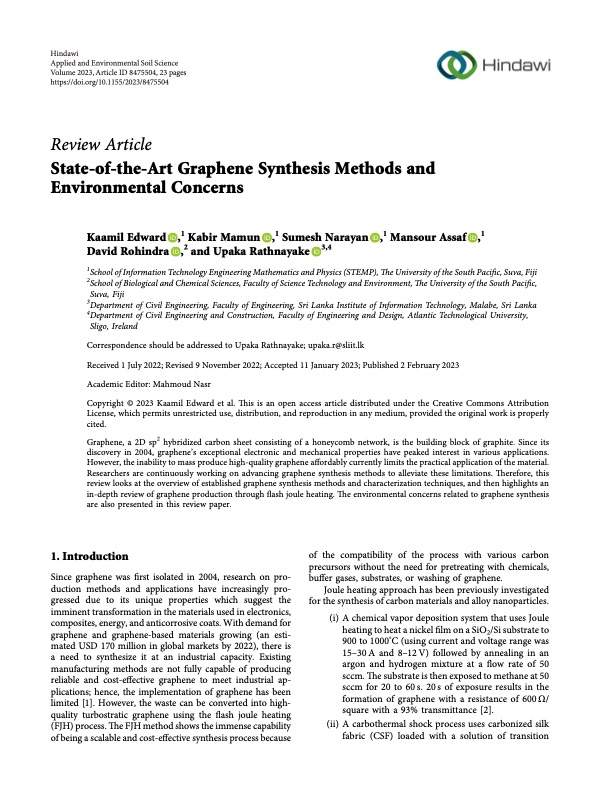
PDF Publication Title:
Text from PDF Page: 001
Hindawi Applied and Environmental Soil Science Volume 2023, Article ID 8475504, 23 pages https://doi.org/10.1155/2023/8475504 Review Article State-of-the-Art Graphene Synthesis Methods and Environmental Concerns Kaamil Edward ,1 Kabir Mamun ,1 Sumesh Narayan ,1 Mansour Assaf ,1 David Rohindra ,2 and Upaka Rathnayake 3,4 1School of Information Technology Engineering Mathematics and Physics (STEMP), Te University of the South Pacifc, Suva, Fiji 2School of Biological and Chemical Sciences, Faculty of Science Technology and Environment, Te University of the South Pacifc, Suva, Fiji 3Department of Civil Engineering, Faculty of Engineering, Sri Lanka Institute of Information Technology, Malabe, Sri Lanka 4Department of Civil Engineering and Construction, Faculty of Engineering and Design, Atlantic Technological University, Sligo, Ireland Correspondence should be addressed to Upaka Rathnayake; upaka.r@sliit.lk Received 1 July 2022; Revised 9 November 2022; Accepted 11 January 2023; Published 2 February 2023 Academic Editor: Mahmoud Nasr Copyright © 2023 Kaamil Edward et al. Tis is an open access article distributed under the Creative Commons Attribution License, which permits unrestricted use, distribution, and reproduction in any medium, provided the original work is properly cited. Graphene, a 2D sp2 hybridized carbon sheet consisting of a honeycomb network, is the building block of graphite. Since its discovery in 2004, graphene’s exceptional electronic and mechanical properties have peaked interest in various applications. However, the inability to mass produce high-quality graphene afordably currently limits the practical application of the material. Researchers are continuously working on advancing graphene synthesis methods to alleviate these limitations. Terefore, this review looks at the overview of established graphene synthesis methods and characterization techniques, and then highlights an in-depth review of graphene production through fash joule heating. Te environmental concerns related to graphene synthesis are also presented in this review paper. 1. Introduction Since graphene was frst isolated in 2004, research on pro- duction methods and applications have increasingly pro- gressed due to its unique properties which suggest the imminent transformation in the materials used in electronics, composites, energy, and anticorrosive coats. With demand for graphene and graphene-based materials growing (an esti- mated USD 170 million in global markets by 2022), there is a need to synthesize it at an industrial capacity. Existing manufacturing methods are not fully capable of producing reliable and cost-efective graphene to meet industrial ap- plications; hence, the implementation of graphene has been limited [1]. However, the waste can be converted into high- quality turbostratic graphene using the fash joule heating (FJH) process. Te FJH method shows the immense capability of being a scalable and cost-efective synthesis process because of the compatibility of the process with various carbon precursors without the need for pretreating with chemicals, bufer gases, substrates, or washing of graphene. Joule heating approach has been previously investigated for the synthesis of carbon materials and alloy nanoparticles. (i) A chemical vapor deposition system that uses Joule heating to heat a nickel flm on a SiO2/Si substrate to 900 to 1000°C (using current and voltage range was 15–30A and 8–12V) followed by annealing in an argon and hydrogen mixture at a fow rate of 50 sccm. Te substrate is then exposed to methane at 50 sccm for 20 to 60 s. 20 s of exposure results in the formation of graphene with a resistance of 600 Ω/ square with a 93% transmittance [2]. (ii) A carbothermal shock process uses carbonized silk fabric (CSF) loaded with a solution of transitionPDF Image | State-of-the-Art Graphene Synthesis Methods

PDF Search Title:
State-of-the-Art Graphene Synthesis MethodsOriginal File Name Searched:
8475504.pdfDIY PDF Search: Google It | Yahoo | Bing
Salgenx Redox Flow Battery Technology: Power up your energy storage game with Salgenx Salt Water Battery. With its advanced technology, the flow battery provides reliable, scalable, and sustainable energy storage for utility-scale projects. Upgrade to a Salgenx flow battery today and take control of your energy future.
| CONTACT TEL: 608-238-6001 Email: greg@infinityturbine.com | RSS | AMP |